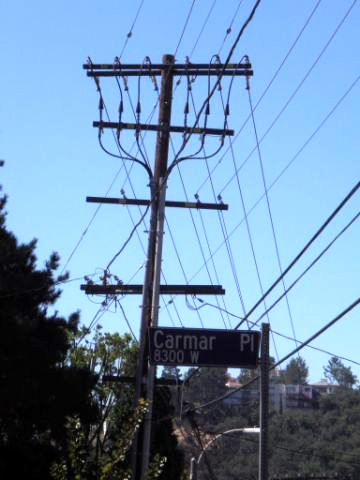BEVERLY HILLS—Have you recently noticed lots of guys working on utility poles? I thought it was odd that some trucks belonged to the Los Angeles Department of Water and Power (LADWP) while others were unmarked. When I first moved into the hills, there were a few wires: one for telephone lines and one maybe for power lines. Then came the cable services. Now, the whole business has gotten out of hand. I noticed that the utility poles and their new wires were mostly on the poles that were susceptible to our strong winds, which whip through the canyons at 50 to 70 mph, tearing down branches and whole trees. So I asked one of the crew bosses if the “people in charge” ever thought about the danger of where they were locating these new wires. “I have no idea,” he said.
I knew someone who had a business that took down old copper wiring and sold it to developing countries. That might make it more reasonable, but he’s moved on to another business.
I did some research. I was right, they are dangerous. The 2007 Malibu fire, which torched 14 homes, was blamed on three snapped utility poles that had been overburdened with service wires. I’m also right that they are unsightly. Delhi ordered the removal of overhead wiring in preparation for the Commonwealth Games. Hmm, a government with good sense!
For us, the problem with the overhead wires falls to LADWP and the Bureau of Engineering. They are supposed to supervise utility poles and the wire and cable industry. We have a Municipal Ordinance that should cover the proliferation of overhead wiring. Operators need to ask for a permit, but by all reports, it’s just a rubber stamp affair where the city makes money by collecting fees and doing nothing.
“Telecom companies publicly confirm that thousands of antennas are…being installed…LADWP doesn’t know how many…or where they are located. Seventy-five organizations and over a million stakeholders city-wide have formally…requested meaningful reform of Los Angeles’ wireless facilities regulations,” reads a letter from a concerned residents’ association.
Many groups are writing to City Council members to create a record.
As if the whole mess would be that simple right? Well, it seems that the Telecommunications Act in 1996 added language to “accelerate rapidly private sector deployment of advanced services and information technologies and services.” And the Wild West of wiring began.
So what’s the balance? We all want cell phones and Internet service that operates at the blink of an eye. The answer may just be in the paperwork. Utilities are obligated to prepare a “pole loading worksheet.” It’s an engineering calculation that is commonly used in determining how weather will affect bridges or tall buildings. It’s also required for determining original placement of utilities poles, and more importantly should be recalculated when an additional burden is placed on a pole with each new series of cables that are strung up. Maybe full disclosure will make these companies more judicious in their decision making.
And yes, there is a specific PUC provision that requires abandoned lines to be removed. According to the Public Utilities Commission General Order 75, “Lines or portions of lines permanently abandoned shall be removed by their owners so that such lines shall not become a public nuisance or a hazard to life or property.” Call April Mulqueen, the head of the CPUC Policy and Planning Division, at 415-703-2329 and ask her who takes down the abandoned wires.






